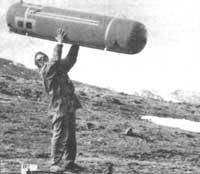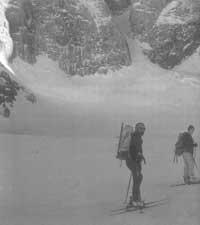Health in height
1989/02/01 Irazabalbeitia, Inaki - kimikaria eta zientzia-dibulgatzaileaElhuyar Fundazioa Iturria: Elhuyar aldizkaria
Elh.- How did you raise the issue of health in the expedition?

J.F. In an expedition like Azkona- Gurea, that is, a group of friends without much money, everyone who walks to the mountain has to contribute something to get the mountain. You cannot accept a person who will not contribute directly from the point of view of mountaineering and who will cost the money to take it. That is why a member of the spy will have to assume the work of the doctor and in those matters is usually the most amateur. In this case, I knew how to become a doctor.
Elh.- How did you raise your work?
JFA.- The Mountain Federation has a medical specialist in sports medicine, Ramón Garate, who is responsible for advising expeditions from the health point of view. I went to him. According to the type of expedition, the size and other factors, has prepared some models of kit. That is, if you travel to the Himalayas, you have to carry these medicines and also if you are five people the other aspirin.
Elh.- How are the problems that can be found in the Himalayas?
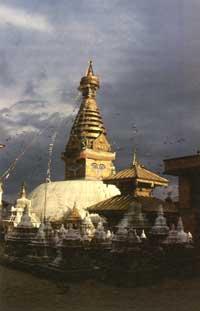
JFA.- Attending the Himalayas can be divided into three groups the possible health problems. On the one hand, the usual among us: waterfalls, etc. On the other hand, the presence of tropical diseases in the tropical environment of Nepal. And finally, the problems related to altitude, typical of the heights.
If we consider tropical diseases, it is convenient to take some vaccines before you leave. The oral vaccine against malaria should be taken. Also anti-hepatitis, because apart from hepatitis improves the immune status of the body a lot. Another problem are dissenters. It is not strange that the state of health is not good or that water or food is in poor condition. A normal traveler, less than three days old, does not hurt much, but the mountaineer who has to climb the mountain can lose shape. In addition to Nepal, dysentery is an endemic area of amobia, so you should know what is the cause before diarrhea to then give it the most appropriate medication.
In the kit offered by Ramón Garate there was a coryllium for the eyes. At first it did not seem very useful to us, but in the end it was otherwise because we had many eye infections.
Lh.- What is the cause of these infections?
DFG.- Especially low level of environmental health. Not knowing why the eye was rising in the morning as a ping-pong ball. These eye problems occurred to us in a certain area during the go and arrival.
Lh.- What problems does height pose?
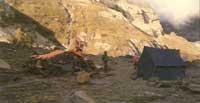
JFA.- The most serious problems in this type of expedition are those caused by altitude, since if it is fatal you can lose your life. When the partial pressure of the atmospheric oxygen rises up, the change of oxygen in the pulmonary alveoli is lower and therefore the supply of oxygen in the blood decreases. How does the body solve this problem? At first it accelerates cardiac and respiratory rhythms. The heart makes 120 beats per minute instead of the usual 60 and consumes a lot of energy. The organism must compensate, spend less energy, increasing the concentration of red cells in the blood.
A very curious phenomenon occurs. When a wound is made, such as ice or piolet, the color of the blood is much more intense than normal; it can be said that it is not red and has a garnet color; it gets very fat, with chocolate texture. This is because you have many red cells in your blood, specifically polyglobulia.
Elh.- I have heard that pulmonary edema is one of the problems of altitude. What can you explain about it?
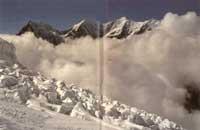
JFA.- As I said before, one of the mechanisms that the body uses to combat oxygen scarcity is the increase in heart rate. This causes an increase in precapillary blood pressure in the alveoli and excessive pressure for the blood to circulate normally in the pulmonary alveoli. The result is the accumulation of water in the lungs, pulmonary edema. Edema is the result of a conditioning mechanism that exceeds 3,000 m. After spending the sixth day above 3,500 m, the risk of pulmonary edema due to the fact that the mechanism of polyglobulia has begun to work disappears.
Symptoms of pulmonary edema are cough, expectoration, and dyspnea
Elh.- What to do when symptoms of pulmonary edema appear?
DFG.- You only have a good solution: Descend below 2,500 m. When there is an altitude problem, such as edema of the lungs or cerebral edema which I will explain later, the person with this problem has not adapted to the mind. I mean that as the person who has no problems is acclimatizing, after a few days at that altitude. But whoever has had a acclimatization problem will not get anything at that altitude. It will be worse, because as the days pass, your health status will become worse. The best is to lose altitude as soon as possible.
Elh.- Just mention the cerebral edema. What is it?
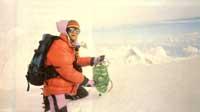
JFA.- Cerebral edema is a consequence of polyglobulia. The blood, having many red cells, becomes very thick and has difficulty walking through the narrow blood vessels. And as in the lungs, when there is difficulty in blood circulation in the brain, water begins to accumulate in the brain membranes. Water stored in the brain presses and can cause death.
I have seen such a case and it is exciting. In the Andes I saw an English in '86 and on the cause of cerebral edema, a plant human being: he had a lost look, did not hear, did not feel or suffered. In addition, this situation has no return.
Typical of the Andes is pulmonary edema. It is necessary to make a very fast acclimatization and the altitude of the mountains is lower. Take the bus in the Andes in Lima and one day you get up to the altiplano, at 4.000 m. There is no adequate form of acclimatization. However, in the himalayas, cerebral edema may occur more easily, since the altitude is higher.
The most important symptoms of cerebral edema are lack of coordination and choking. A type of test is proposed to detect possible simple sums when it is lowered every morning. If you do not get it, it is best to start going down as soon as possible.
Elh.- Have you had freezing problems?
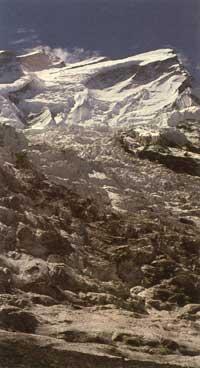
JFA.- Well, I'm going to explain the mechanism of freezes. There are two main causes. On the one hand, polyglobulia. The blood is thicker and has difficulty circulating through the narrow blood vessels of the extremities and cannot carry the necessary heat. On the other hand, fatigue causes blood to go to the organs needed to live in greater measure (brain, kidneys, lungs) and not to the branches.
What to do against blood fat? You have to drink a lot. At altitude much liquid is lost. The environment is very dry, as above the water vapor pressure is also low. In the breath, much liquid is lost. The basis of food are dry things, you can't climb vegetables. You have to get all the water melting the snow and it is a very tired job. Imagine that you arrive at the tired shop at the end of the day and you have to be long warming up the snow in the fire so it doesn't fall, taking the hand out of the snow... The morning before the summit I was 2 and a half hours to get 7 liters of water. You are against your will because you are tired and you prefer to be asleep, but if you want to last you have to do it obligatorily.
Elh.- Could you say if it was about the food you have had?
JFA.- In expeditions like ours there are three types of food: the one of approach march, the one of base camp and the one of camping in altitude. We bought in Nepal the food we ate in the approach march and in the base camp: macaroni, pasta, pastries, jams, bread, vegetables, etc. In addition, we took vitamin concentrates to balance the diet. In the altitude camps we took dehydrated food and vitamin concentrates. It was impossible to drink fresh foods, since on the one hand the weight to rise increases a lot and on the other the risk of losing. However, without looking at the weight you raise a whim. We, for example, climb a chorizo peak.
* * * * * * * * * * * * * * * * * * * * * * * * * * * * * * * * * * * * * * * * * * * * * * * * * * * * * * * * * * * * * * * * * * * * * * * * * * * * * * * * * * * * * * * * * * * * * * * * * * * * * * * * * * * * * * * * * * * * * * * * * * * * * * * * * * * * * * * * * * * * * * * * * * * * * * * * * * * * * * * * * * * * * * * * * * * * * * * * * * * * * * * * * * * * * * * * * * * * * * * * * * * * * * * * * * * * * * * * * * * * * * * * * * * * * * * * * * * * * * * * * * * * * * * * * *
We conclude the dialogue we had with Juan Fernando Azkona about the Goimendi and now we think we know something more.

Gai honi buruzko eduki gehiago
Elhuyarrek garatutako teknologia




